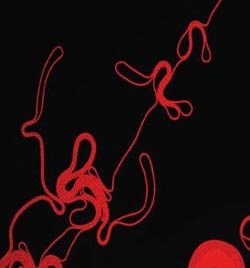New role for protein family could provide path to how crop traits are modified

Fluorescence micrograph of a mutant of the filamentous cyanobacterium Fremyella diplosiphon showing the autofluorescence that results from the overaccumulation of the photosynthetic pigment phycoerythrin. This phenotype can result from the deletion of the gene encoding a translation initiation factor 3. | Photo by Xin Zhang and Lina Li<br>
The protein, called translation initiation factor 3, or IF3, is one of three proteins that make up the core structure of the machinery needed to guide the joining of messenger RNAs and ribosomes as protein translation commences. These three proteins have been widely considered to simply operate in a constitutive manner and play little, if any, role in regulating the expression of genes.
The new findings, from the laboratory of David M. Kehoe, professor of biology in the Indiana University Bloomington College of Arts and Sciences, reveals that IF3, in addition to its well-accepted function during translation initiation, also regulates the expression of genes that encode components of the photosynthetic machinery in response to changes in the color of light in the surrounding environment, a process known as “chromatic acclimation.”
These photosynthesis genes produce red-pigmented proteins called phycoerythrin in cyanobacteria when the cells are grown in green light and allow these organisms to efficiently absorb the predominant ambient light color for photosynthesis. The team uncovered the novel function of IF3 while searching for mutants that incorrectly regulated phycoerythrin. The discovery of this mutant was at first surprising, because in all other bacteria that have been examined, mutations in infC (the gene that encodes IF3) are lethal.
The team solved this puzzle by uncovering a second infC gene in Fremyella diplosiphon, the model organism for the study of light color responsiveness in cyanobacteria. While both IF3s, which have been named IF3a and IF3b, can act in the traditional role of translation initiation, only IF3a was found to also regulate photosynthetic gene expression.
By exploring the genomes of hundreds of prokaryotes and eukaryotes in collaboration with members of the laboratory of Indiana University Distinguished Professor and Class of 1955 Professor Jeffrey Palmer, the group identified a wide range of species whose genomes appear to have the potential to encode multiple IF3s, with one organism apparently encoding five distinct IF3 family members. And since almost none of these species are capable of chromatic acclimation, Kehoe believes that multiple IF3s must be used to regulate a wide range of environmental and perhaps developmental responses in both prokaryotes and eukaryotes.
“Particularly interesting was our finding that IF3 families exist in a number of plant species, including commercially important crops,” Kehoe said. “This means that new approaches to the modification of traits in agriculturally significant plant species may be possible by manipulating the expression patterns of different IF3 family members.”
The discovery has generated excitement for an additional reason. Historically, scientists have had a difficult time studying IF3 because it is so essential for translation initiation that it can not be altered without causing death. In fact, it remains one of the few proteins involved in translation for which no effective antibiotic has been developed. But the ability of the Kehoe team to delete either of the two infC genes in F. diplosiphon without causing lethality will allow the group to modify both IF3a and IF3b at will.
“Now that we know that F. diplosiphon contains two functionally different IF3s, and that each is nonessential, we have a unique opportunity to enhance our understanding of how the structural features of IF3 are related to its function,” Kehoe said. “Advancing our understanding of the role of IF3 in translation is likely to provide opportunities to develop new antibiotics that are targeted to this class of proteins.”
“A unique role for translation initiation factor 3 in the light color regulation of photosynthetic gene expression” is now available in early online editions of the Proceedings of the National Academy of Sciences. Co-authors with Kehoe and Palmer were Andrian Gutu, a former Ph.D. student in the Kehoe lab who is now a Howard Hughes Medical Institute Postdoctoral Fellow at Harvard University; April Nesbit, a former postdoctoral researcher in the Kehoe lab who is now a lecturer at Purdue Northwest; and Andrew Alverson, a former postdoctoral fellow in the Palmer lab who is now a faculty member at the University of Arkansas. Primary funding for the work was provided by the National Science Foundation, with support provided to Nesbit by the National Institutes of Health.
Media Contact
More Information:
http://www.iu.eduAll latest news from the category: Agricultural and Forestry Science
Newest articles

Compact LCOS Microdisplay with Fast CMOS Backplane
…for High-Speed Light Modulation. Researchers from the Fraunhofer Institute for Photonic Microsystems IPMS, in collaboration with HOLOEYE Photonics AG, have developed a compact LCOS microdisplay with high refresh rates that…

New perspectives for material detection
CRC MARIE enters third funding period: A major success for terahertz research: Scientists at the University of Duisburg-Essen and the Ruhr University Bochum have been researching mobile material detection since…

CD Laboratory at TU Graz Researches New Semiconductor Materials
Using energy- and resource-saving methods, a research team at the Institute of Inorganic Chemistry at TU Graz aims to produce high-quality doped silicon layers for the electronics and solar industries….



